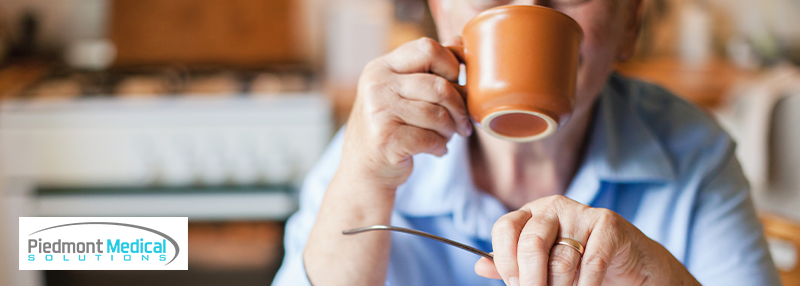Piedmont Medical Solutions
Updated 4:22 PM CDT, Mon October 6, 2025
Published Under: Bladder Health Incontinence Urological

Fall is a season of cozy soups, spiced drinks, and hearty dishes. But for people managing bladder issues, whether due to incontinence, catheter use, overactive bladder, or other urology concerns, some of those seasonal favorites can be irritants. What you eat and drink has a powerful effect on bladder health.
In this guide, we’ll go through bladder-irritating foods, bladder-friendly fall foods, hydration strategies, and how Piedmont Medical Solutions supports your entire bladder health journey with quality supplies and guidance.
1. How Food Impacts Bladder Health
Your bladder is sensitive to what passes through it. The urine that interacts with bladder tissues can carry irritants, acids, and compounds that trigger urgency, leaks, or discomfort.
- Certain foods and beverages act as bladder irritants and may worsen symptoms.
- Especially for those using catheters or pads, reducing irritation can help minimize leaks and reduce inflammation.
- Diet alone won’t cure bladder conditions, but it can reduce symptom burden, improve comfort, and support overall urinary health.
Before making changes, always consult your urologist or care team as your personal triggers may differ.
2. Fall Foods That Support Bladder Health
When the air turns crisp, these choices can help soothe rather than irritate your bladder:
Root & Squash-Based Veggies
- Butternut, acorn, kabocha, pumpkin, sweet potato – gentle on the bladder, rich in beta-carotene.
- These are often well-tolerated vs. acidic vegetables like tomatoes.
Low-Acid Fruits
- Pears, apples (peeled), blueberries, cantaloupe, honeydew
- These fruits are lower in acid, making them safer for sensitive bladders.
Lean Proteins
- Skinless poultry, fish, legumes, egg whites
- Protein helps you feel full without bladder irritation.
Fiber-Rich Whole Grains
- Oats, brown rice, quinoa, whole-grain bread
- Fiber helps prevent constipation, which can pressure the bladder and worsen symptoms.
Hydrating Vegetables
- Cucumber, zucchini, green beans (in moderation)
- Provide hydration without over-loading your fluid intake, and are typically less irritating than fruits like watermelon.
Spices Gently Used
- Mild herbs like rosemary, parsley, thyme
- Try avoiding heavy spice blends (e.g. chili, curry) that may trigger urgency.
Piedmont Tip: Introduce new foods one at a time and track any symptom changes for a few days.
3. Common Bladder Irritants to Avoid (or Limit)
These foods and drinks are often flagged by urology experts for triggering bladder symptoms:
- Caffeine and caffeinated beverages (coffee, tea, energy drinks)
- Alcohol (beer, wine, spirits)
- Carbonated beverages (sodas, sparkling waters)
- Citrus fruits and juices (oranges, grapefruit, lemons, limes)
- Tomato-based products (sauces, ketchup, salsa)
- Spicy foods and heavy seasoning
- Artificial sweeteners, MSG, additives
- Acidic or pickled foods (vinegars, pickles)
Because individual sensitivity varies greatly, many people benefit from keeping a simple food-bladder diary to identify personal triggers.
4. Hydration Strategies That Help, Not Hurt
Hydration is still key, because drinking too little can concentrate urine, irritate the bladder, and worsen symptoms. But overhydrating with fluids full of irritants is also risky.
Smart Hydration Tips:
- Aim for pale straw-colored urine (most days)
- Drink filtered water, decaf herbal tea (non-citrus), or low-acid drinks
- Use ice chips or water-rich vegetables for subtle hydration
- Avoid drinking large amounts before bed
- For catheter users, hydration helps keep tubing flowing and reduces blockage risk
Aiming for 4–8 cups (32–64 oz) per day is a general guideline, but your physician’s recommendation may vary based on health conditions.
5. Sample Fall Menu for Bladder Comfort
Here’s a simple full-day menu with bladder-friendly fall foods:
| Meal | Bladder-Friendly Option |
|---|---|
|
Breakfast |
Oatmeal topped with blueberries and peeled apple slices |
|
Snack |
A small handful of almonds + pear slices |
|
Lunch |
Roasted butternut squash soup + grilled chicken breast |
|
Snack |
Low-acid herbal tea + rice cakes |
|
Dinner |
Baked salmon, steamed green beans, brown rice |
|
Dessert |
Baked pear with a sprinkle of cinnamon |
Remember: moderation, portion control, and spacing your food intake evenly can help reduce bladder stress.
6. When Diet Isn’t Enough: Urology Support & Supplies
Diet is one tool in the toolbox, but when you live with bladder issues, you often need the right medical supplies and support as well. That’s where Piedmont Medical Solutions steps in.
Here’s how we help:
- Wide selection of catheters, incontinence pads/briefs, and urology supplies
- Personalized guidance for selecting the right product for your comfort and lifestyle
- Monthly reordering services to avoid supply gaps
- Insurance and Medicare support to ease cost burden
- Educational resources (blogs, tips, tutorials) to partner with you in care
Together, diet + supplies + care = better quality of life.
7. Final Thoughts & Next Steps
Fall can be a beautiful time, but for many with bladder sensitivity or incontinence, it also brings challenges. By consciously choosing bladder-friendly fall foods, reducing irritants, and staying smart about hydration, you’re giving your bladder a better chance to thrive.
If you’re unsure about your triggers, want help selecting urology supplies, or simply want a partner in your bladder health, Piedmont Medical Solutions is here for you.
Ready to explore product options or get personalized help?

Comments